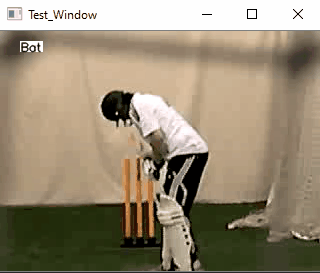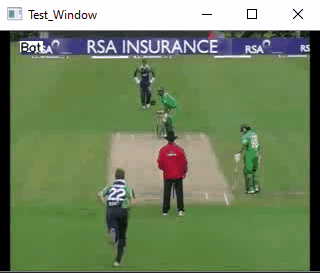Video classification using VGG16 as a feature extractor and seasoning with RNN. Dataset used is UCF101 (Cricket bowling and batting classes).
A simple RNN is used to better classify temporal frame sequences from videos.
| Cricket batting | Cricket batting/bowling |
|---|---|
 |
 |
Some of the use cases would be monitoring anomalies, suspicious human actions, alerting the staff/authorities.
Feature extraction:
- Pretrained VGG16 is used as a feature extractor after fine tuning/unfreezing its 4 top layers.
- A simple classifier is then connected to VGG16 and trained to identify if the frame belongs to class1 or 2.
- Then the top classifier is disconnected and only dense layer with 1024 output size is used to obtain the sparse representations of each frame.
- Data to lstm format: For each video frame, the sparse representations are stacked into a tensor of size (NUM_FRAMES, LOOK_BACK, 1024).
RNN:
- A standard LSTM is used. Note that you need GPU/CUDA support if you would like to run CUDnnLSTM layers in the model.
- Finally, the LSTM network is trained to distinguish between your desired class1 and 2 videos.
- Install all the required Python dependencies:
pip install -r requirements.txt
- To run inference either on a test video file or on webcam:
python run.py
- Note that the inference is set on the test video file by default.
- To change it, simply set
FROM_WEBCAM = Truein the config. options at mylib/Config.py - Trained model weights (for this example) can be downloaded from here. Make sure you extract them into the folder 'weights'.
- The class probabilities and inference time per frames is also displayed:
[INFO] Frame acc. predictions: 0.91895014
Frame inference in 0.0030 seconds
- You can also chose to send prediction accuracies over the mail if desired. Follow the instructions in mylib>Mailer.py (to setup the sender mail).
- Enter the receiver mail in the config. options at mylib/Config.py
- In case of severe false positivies, make sure to optimize the threshold and positive_frames parameters to further narrow down the predictions. Please refer config.
Threshold = 0.50
if pred >= Threshold:
if total_frames > 5:
print('[INFO] Sending mail...')
- Some image processing is required before training on your own data!
- In 'Preprocessing.ipynb' file, the frames from each video classes are extracted and sorted into respective folders.
- Note that the frames are resized to 224x224 dimensions (which is VGG16 input layer size).
- The dataset can be downloaded from here.
- 'Train.ipynb', as the name implies trains your model.
- Training is visualized with the help of TensorBoard. Use the command:
tensorboard --logdir data/_training_logs/rnn
- Make sure to review the parameters in config. options at mylib/Config.py
- You will come across the parameters in Train.ipynb, they must be same during the training and inference.
- If you would like to change them, simply do so in the training file and also in config. options.
Main:
- VGG16 paper: https://arxiv.org/pdf/1409.1556.pdf
- UCF101 Action Recognition Data Set: https://www.crcv.ucf.edu/data/UCF101.php
Optional:
- TensorBoard: https://www.tensorflow.org/tensorboard
- Investigate and benchmark different RNN architectures for better classifying the temporal sequences.
To get started/contribute quickly (optional) ...
-
Option 1
- 🍴 Fork this repo and pull request!
-
Option 2
- 👯 Clone this repo:
$ git clone https://github.com/saimj7/Action-Recognition-in-Real-Time.git -
Roll it!
saimj7/ 06-09-2020 © Sai_Mj.


